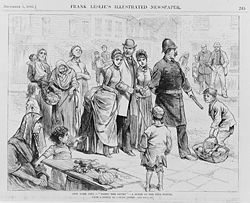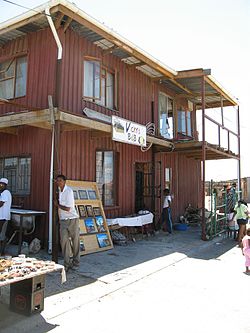- Slum tourism
-
 Slum tourism in Five Points, Manhattan in 1885
Slum tourism in Five Points, Manhattan in 1885
 Bed and breakfast inside a South African township
Bed and breakfast inside a South African township
Slum tourism is a type of tourism that involves visiting impoverished areas, which has become increasingly prominent in several developing countries like India, Brazil, Kenya, and Indonesia [1] The concept began in poor sections of London and by 1884 had started in Manhattan.[2]
Contents
History
The Oxford English Dictionary dates the first use of the word "slumming" to 1884. In London, people visited neighborhoods such as Whitechapel or Shoreditch to see how the poor lived. In 1884 the concept moved to New York City to the Bowery and the Five Points area of the Lower East Side were visited to see "how the other half lives." [3]
In the 1980s in South Africa "township tours" were organised to educate local governments on how the black population lived. It then attracted international tourists that wanted to support and learn more about apartheid.[4]
Prior to the release of Slumdog Millionaire in 2008, Mumbai was a slum tourist destination for slumming. [5] The concept of slum tourism has recently started to gain more attention from media and academia alike. In December 2010 the first international conference on slum tourism was held in Bristol,[6] while a social network of people working in or with slum tourism has been set up as well.[7]
Locations
Slum tourism is mainly performed in urban areas of developing countries, most often named after the type of areas that are visited:
- Township tourism: in post-apartheid South Africa and Namibia. South African settlements are still visibly divided into wealthy, historically white suburbs and poor, historically black townships, because of the effects of apartheid and racial segregation.
- Favela tourism: in Brazil
- Hutong trips in larger Chinese cities, such as Hutongs in Beijing.
Motivations
A 2010 study by the University of Pennsylvania showed that tourists in Mumbai's Dharavi slum were motivated primarily by curiosity, as opposed to several competing push factors such as social comparison, entertainment, education, or self-actualization. In addition, the study found that most slum residents were ambivalent about the tours, while the majority of tourists reported positive feelings during the tour, with interest and intrigue as the most commonly cited feelings.[8]
Criticism
Critics say slum tourism, like poorism, is likened to a kind of voyeurism, exploiting people less fortunate, snapping pictures and leaving nothing in return. Some tours do use portions of the profits to help out however.
They have also courted controversy because of disputes about their safety, and fears that they misrepresent local culture.
References
- ^ "Slum Tourism: A Trip into the Controversy". May 15, 2010. http://repository.upenn.edu/cgi/viewcontent.cgi?article=1011&context=uhf_2010. Retrieved 2011-07-25.
- ^ "Slumming In This Town. A Fashionable London Mania Reaches New-York. Slumming Parties To Be The Rage This Winter. Good Districts To Visit. Mrs. Langtry As A Slummer". New York Times. September 14, 1884. http://select.nytimes.com/gst/abstract.html?res=F50E12F8385C15738DDDAD0994D1405B8484F0D3. Retrieved 2010-12-08. "'Slumming', the latest fashionable idiosyncrasy in London -- i.e., the visiting of the slums of the great city by parties of ladies and gentlemen for sightseeing -- is mildly practiced here by our foreign visitors by a tour of the Bowery, winding up with a visit to an opium joint or Harry Hill's. ..."
- ^ Marc Saint-Upéry (October 21, 2010). "Left at the Crossroads: Ogling the poor". RIA Novosti. http://en.rian.ru/columnists/20101021/161035393.html. Retrieved 2010-12-08. "The word 'slumming' was first registered by the Oxford Dictionary in 1884, coinciding with a rising Victorian preoccupation that mixed philanthropy, social paranoia and voyeuristic titillation. Respectable middle-class Londoners would visit seedy neighborhoods such as Whitechapel or Shoreditch, while wealthy New Yorkers roamed the Bowery and the Lower East Side to see “how the other half lives.” At the turn of the century, though, the practice had already begun to decline"
- ^ Dondolo, L., 2002. The construction of public history and tourism destinations in Cape Town's townships: A study of routes, sites and heritage. Cape Town: University of the Western Cape
- ^ "Slum Tourism: A Trip into the Controversy". May 15, 2010. http://repository.upenn.edu/cgi/viewcontent.cgi?article=1011&context=uhf_2010. Retrieved 2011-07-25.
- ^ "Destination Slum"
- ^ "Slumtourism.net - Network for people working in or with slum tourism"
- ^ "Slum Tourism: A Trip into the Controversy". May 15, 2010. http://repository.upenn.edu/cgi/viewcontent.cgi?article=1011&context=uhf_2010. Retrieved 2011-07-25.
External links
Categories:- Types of tourism
Wikimedia Foundation. 2010.
